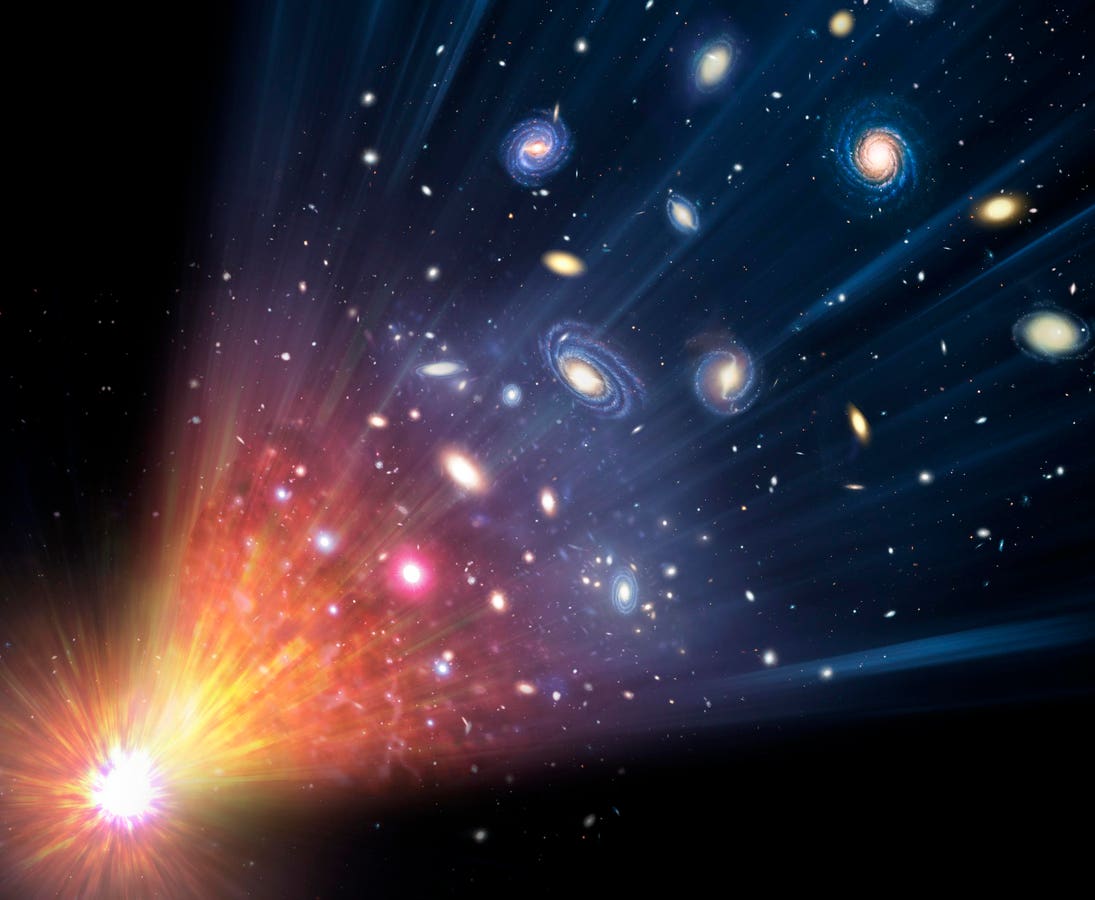Big Bang and expanding universe. Illustration showing the universe expanding over time (bottom left to top right). Matter formed after the Big Bang (bottom left), the initial expansion of the universe from an infinitely compact state 13.8 billion years ago. Around 100 million years after the Big Bang, the first stars and galaxies formed. On the largest scale, the galaxies are observed to be moving away from each other. This is due to the expansion of the universe
getty
Lithium, currently in such high demand for electric vehicles and smart phones, also continues to push astrophysical theory to the limit. Known as the Cosmological Lithium Problem, the primordial abundance of this light metal has puzzled astrophysicists for more than two decades now. And the eventual solution to this conundrum might require new physics.
The crux of the issue is the observed underabundance of Lithium-7, a stable isotope of Lithium that consists of three protons and four neutrons.
For every nucleus of lithium, there are two billion nuclei of hydrogen in the early universe, Andreas Korn, a stellar astrophysicist at Uppsala University in Sweden, tells me in Stockholm.
And among old galactic halo stars, the Lithium-7 underabundance is a factor of two to three below big bang nucleosynthesis predictions. That is, the process that (within the first three minutes after the big bang) produced the first light elements — hydrogen, helium, and tiny amounts of lithium and beryllium.
Lithium is not a rare earth element, but it is a very rare element in the cosmos — about nine orders of magnitude less than hydrogen and five orders of magnitude less than oxygen in the present-day universe.
Why Does This Matter?
The Lithium-7 problem is important because it poses the only remaining inconsistency in big bang nucleosynthesis, says Korn. Too much Lithium-7 was produced in the big bang, and we see too little of it in old stars, he says.
If it’s not solved through conventional theory, then the door will inherently be left ajar for new physics.
Defining the true nature of the universe’s exotic dark matter, for instance, through big bang nucleosynthesis or some other observation would represent a revolution in fundamental physics, says Korn.
Physicists know that the standard model of particle physics is not complete.
Unsurprisingly, we physicists are looking for clues other than the gravitational effects of the cosmos’ missing exotic dark matter to further constrain the realm of new physics, says Korn. Discrepancies in BBN could provide such clues, he says.
The hope has been that such an extension of conventional physics could at the same time explain the cosmos’ elusive dark matter.
The Lithium problem was aptly described in a 2011 review paper.
In a paper appearing in the journal Annual Reviews of Nuclear and Particle Science, author Brian Fields notes that BBN represents our earliest reliable probe of the cosmos. However, Lithium-7 observations lie at least a factor of three below predictions, he writes.
And in the last 14 years since Fields’ paper was published, there has only been incremental progress in resolving this Lithium-7 discrepancy.
Precise observations of solar neutrinos also point to new physics.
Nuclear reaction networks applied to the Sun predict how many neutrinos are created in the fusion reactions, but it turns out that the number of electron neutrinos falls short of expectations, says Korn. They are changed to other types of neutrinos on the way to us, through a process called neutrino oscillations, he says.
BBN also tells us that there were three neutrino types present in the early universe. Any discrepancy between BBN predictions and observations could, in principle, provide such clues for new physics.
But there is a possibility that most of this problem is simply solved by conventional stellar physics, says Korn.
In BBN, Lithium represents only a trace element. In the Sun, 99.5% of the lithium is gone because it has been mixed down to layers that are hotter than two and a half million degrees Kelvin, and that Lithium has disintegrated.
Tracing Old Stars
Halo stars are very old, metal poor stars on the outskirts of our own Milky Way Galaxy that can trace the state of the universe as it was 10 or 12 billion years ago, says Korn.
Stellar Mixing
But the challenge is that astronomers have a hard time determining how much lithium and other elements have been mixed deep into the interior of the target star. In particular, theorists need to know how much mixing of lithium occurs at the boundary between the star’s outer convective envelope and its stellar interior.
As in a hot pot of soup, stellar material that is brought to the bottom of the convection zone reaches temperatures of two and a half million Kelvin and subsequently destroyed, says Korn.
Hard Work
Korn says that particle physicists, nuclear theorists and observational astrophysicists have all had their nose to the grindstone, trying to resolve this lithium-7 underabundance issue for decades now.
It’s important to understand just how much lithium is depleted by stars because only then can we scientifically address the remaining cosmological lithium problem, says Korn.
Caption:MIT astronomers discovered three of the oldest stars in the universe, and they live in our own galactic neighborhood. The stars are in the Milky Way’s “halo” — the cloud of stars that envelopes the main galactic disk — and they appear to have formed between 12 and 13 billion years ago, when the very first galaxies were taking shape.
Serge Brunier; NASA
Future Observations
In a 2021 paper published in the journal Experimental Astronomy, the authors write that a proposed European Space Agency mission known as HAYDN (High precision AsteroseismologY of DeNse stellar fields) would potentially see launch by mid-century. If so, it would observe stars in metal-poor globular clusters in both our own Milky Way Galaxy and nearby dwarf galaxies.
The HAYDN mission will be crucial to getting a better handle on the real abundance of Lithium in the Milky Way and nearby dwarf galaxies like the Large and Small Magellanic Clouds via a process known as asteroseismology which uses stellar oscillations (literally seismic waves inside a star) to probe its interior.
These space-based observations, says Korn, would help theorists place better constraints on just how much lithium-7 is being destroyed in stellar interiors.
A Stellar Solution?
I’m upholding the idea that at least part, or even a significant part, of the problem is a stellar problem, says Korn. But it remains a hard nut to crack, he says.








